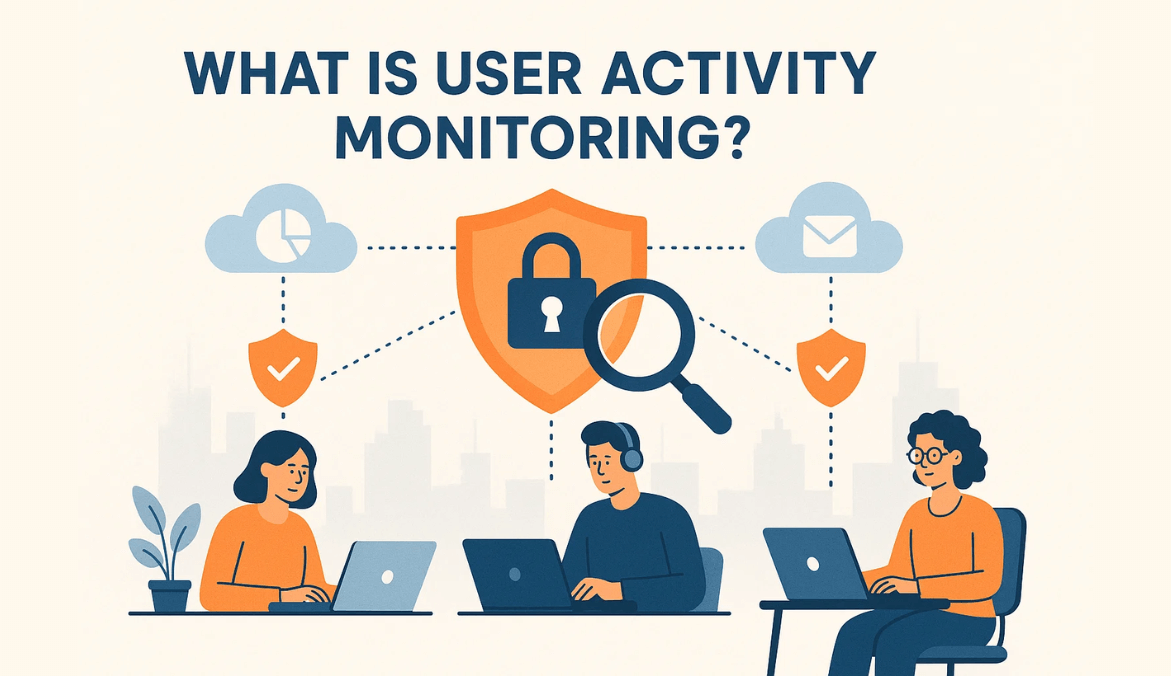Introduction
With 10 years of professional experience—and the last 2 years focused on helping organizations across IT, healthcare, and finance roll out monitoring systems responsibly—I’ve seen one thing become clear: user activity monitoring (UAM) is no longer optional in 2025.
If you’ve managed a team—especially a remote or hybrid one—you’ve probably wondered: what exactly are people doing on their computers, all day? Not out of suspicion, but because visibility is critical for both productivity and security.
That’s where User Activity Monitoring (UAM) comes in. Done right, it prevents risks, helps with compliance, and uncovers bottlenecks—without killing trust.
“When our company went fully remote during COVID, we implemented user activity monitoring for the first time. What surprised us wasn’t just uncovering risky behaviour — but the clarity it gave us into how work was actually happening. We discovered teams were juggling multiple apps for the same tasks, like using three different chat platforms or several project trackers. By standardizing on a single set of tools, we cut out the confusion and boosted overall productivity by nearly 30%.”
Quick Summary
- User Activity Monitoring (UAM) = tracking and analyzing what users do across devices, apps, and networks.
- It supports security, compliance, productivity, and forensics.
- Tools can capture app usage, logins, file transfers, websites, USB use, and more.
- Avoid over-monitoring—focus on useful signals.
- Success = clear policies, right tools, and transparent communication.
How User Activity Monitoring Works (Under the Hood)
According to NIST, user activity monitoring provides visibility into “who is doing what on information systems” — primarily to detect insider threats and enforce compliance standards [NIST/CNSSI 4009-2015].
At its core, UAM collects data from multiple touchpoints:
- Endpoints: computers, laptops, servers.
- Apps & websites: which programs and domains are being used.
- Files & data: downloads, uploads, USB transfers, print jobs.
- Network & SaaS: logins, VPN sessions, API calls, and cloud storage.
Most solutions use endpoint agents or API integrations. Data flows into a central dashboard for trend analysis, anomaly detection, or investigation.
👉 Expert tip: Don’t collect everything. Collect what’s useful and actionable. Too much data = noise.
The Four Pillars of UAM Data Collection
Here’s a structured way to understand what’s monitored and why it matters:
| Pillar | What’s Collected | Why It Matters |
|---|---|---|
| Endpoints | Logins, app usage, idle/active time | Visibility into daily work patterns and insider activity |
| Apps & Websites | Domains visited, SaaS logins, software use | Identifies productivity trends, shadow IT, risky browsing |
| Files & Data | Copy, move, print, USB transfers, uploads/downloads | Protects against data exfiltration and IP theft |
| Network & SaaS | VPN sessions, API calls, cloud storage actions | Critical for compliance, remote workforce, and cloud security |
What UAM Tracks (and What You Should Avoid)
Signals worth tracking:
- App and website usage.
- Logins/logouts and session duration.
- File activity (copy/move/print/download).
- Idle vs active time.
- Risky behaviours (USB devices, shadow IT apps).
What to avoid:
- Keystrokes in personal chats.
- Sensitive personal data (e.g., banking, private emails).
In my audits, I’ve seen companies lose employee trust overnight because they went too far—capturing every keystroke. Instead, focus on patterns of risky behaviour that matter.
Core Use Cases (with Playbooks)
- Security: Detect insider threats or data exfiltration.
- Example: At a healthcare client, UAM flagged a staff member emailing patient record to personal accounts—preventing a major HIPAA violation.
- Compliance: Generate logs to satisfy audits for SOC 2, ISO 27001, HIPAA, or PCI.
- UAM provides the audit trail regulators expect.
- Productivity & Ops: Identify bottlenecks, workload imbalances, or tool misuse.
- When we went remote, activity reports revealed teams juggling three different chat apps. Consolidating saved hours weekly.
- Forensics: Investigate incidents with reliable session data, screenshots, and logs.
UAM vs User Activity Tracking vs Computer Activity Monitoring
These terms often overlap, but the intent differs:
- UAM (User Activity Monitoring): Broad—covers both security and productivity.
- User Activity Tracking: Lighter—focused on team productivity analytics.
- Computer Activity Monitoring: IT/security-centric (apps, files, networks).
👉 Key difference = purpose. Are you preventing threats, boosting productivity, or both?
Industry Playbooks: How UAM is Used Across Sectors
IT & Finance
- Detects fraudulent transactions.
- Logs sensitive file access for SOC 2, SOX, PCI compliance.
Healthcare
- Tracks access to patient records (HIPAA).
- Monitors printing and USB transfers to prevent PHI leaks.
Remote-First Companies
- Tracks SaaS and collaboration tools.
- Detects fake activity (e.g., mouse jigglers) [Wired, 2023].
📊 Remote Reality: Globally, 48% of the workforce works remotely in 2025, and 73% of employers track activity in hybrid setups.
Retail & Manufacturing
- Ensures POS system usage is legitimate.
- Prevents theft through USB/print monitoring.
Legal & Ethical Considerations (2025 Global View)
By 2025, around 70% of large enterprises are expected to actively monitor their workforce. But legality depends on how it’s implemented.
Golden rules:
- Notify & get consent: Update onboarding docs and employee handbooks.
- Map local laws:
- GDPR (EU): Lawful basis, data minimization.
- CCPA (California): Employee privacy rights.
- India DPDP Act (2023): Explicit consent, purpose limitation.
- HIPAA (US Healthcare): Logs for PHI access.
- ISO 27001/SOC 2: Requires access/activity logs.
- Respect privacy: Don’t monitor personal devices without BYOD agreements.
I once saw a firm roll out monitoring without communicating the “why.” Overnight, morale dropped.
Lesson: employees will accept monitoring if it’s framed as fairness, not surveillance.
Implementation Guide (Zero to Live)
Here’s a rollout plan I’ve used with clients:
- Define objectives: Security? Compliance? Productivity?
- Policy first: Write down what’s tracked, what’s not, and why.
- Choose architecture: Agent vs API-based.
- Pilot for 30 days: Start small, measure feedback.
- Scale: Roll out dashboards, train managers, refine alerts.
👉 Pro tip: Involve HR and legal early—it builds credibility and prevents pushback.
From Monitoring to Meaningful Outcomes with Mera Monitor
User Activity Monitoring isn’t just about collecting logs—it’s about transforming data into insights that strengthen security, accountability, and productivity. Mera Monitor takes the guesswork out by providing a structured, transparent, and actionable approach.
- Aligned with Your Policy: Every tracked activity directly reflects the standards you’ve set, ensuring monitoring remains fair and purposeful.
- Built on Transparency: Employees see exactly what’s being monitored, creating trust instead of uncertainty.
- Action Over Overload: Instead of drowning you in data, Mera Monitor highlights risks, trends, and productivity patterns that actually matter.
- Always Evolving: With continuous reporting and analytics, it helps refine your monitoring strategy as your organization grows.
👉 Turn monitoring into measurable results—Start a Free Trial or Book a Demo today with Mera Monitor.
Measuring Success (KPIs & Dashboards)
Security KPIs:
- Mean-time-to-detect insider events.
- Number of risky actions prevented.
Productivity KPIs:
- Idle vs active time trends.
- App usage vs role expectations.
Compliance KPIs:
- Audit findings closed.
- % of required logs captured.
I often tell leaders: Don’t measure hours for the sake of hours. Measure risks reduced, compliance achieved, and bottlenecks fixed.
30-60-90 Day Action Plan
30 Days:
Publish policy, run pilot, gather feedback.
60 Days:
Integrate with SIEM/HRIS, tune alerts, refine reports.
90 Days:
Run first compliance audit, expand to all teams, train managers.
Buyer’s Guide to Activity Monitoring Tools (2025)
When evaluating tools, look for:
- Multi-platform support (Windows, Mac, SaaS).
- Role-based access controls (RBAC).
- Data masking/redaction.
- Real-time alerts without noise.
- Transparent pricing.
👉 Always ask vendors: “How do you handle privacy by default?”
Risks, Pitfalls & How to Avoid Them
- Over-monitoring: Creates fear, reduces trust.
- Alert fatigue: Too many false alarms = ignored alerts.
- No RBAC: Everyone seeing all data = risk.
- Fake activity: “Mouse jigglers” surged during COVID; modern tools now flag them.
📊 Reality check: While 68% of employers believe monitoring boosts output, 56% of employees feel anxious about being monitored
Early in my career, I saw one firm try to monitor everything—keystrokes, screenshots, even bathroom breaks. Within weeks, employees revolted and productivity tanked. Monitoring done wrong backfires hard.
Resources
To help you put User Activity Monitoring into practice, we’ve prepared practical resources you can use right away:
- Monitoring Policy Template – covers purpose, scope, and employee rights.
- Employee Announcement Script – a ready-to-use communication for rollout.
- DPIA Checklist – ensures compliance with privacy and data protection requirements.
- Manager Coaching Guide – helps leaders use monitoring data fairly and constructively.
📥 Download all resources here: User Activity Monitoring Resources 2025 (PDF)
Final Takeaway
User Activity Monitoring has become a 2025 necessity. Done right, it protects companies from threats, ensures compliance, and boosts productivity. Done wrong, it breeds distrust.
The key is balance: clear policies, the right tools, and open communication.
Remember: the goal isn’t to watch employees—it’s to help them succeed while keeping the business secure.
FAQs
Yes — but with conditions. In most jurisdictions, monitoring is legal as long as:
- Employees are notified and, in some regions (EU/India), give explicit consent.
- Data collection is proportionate and necessary (GDPR principle).
- Companies respect off-hours privacy and avoid monitoring personal devices unless there’s a BYOD agreement.
Failing to do so can result in lawsuits, penalties, or regulatory fines.
- UAM (User Activity Monitoring): Focuses on logging and tracking actions (e.g., file transfers, app usage, logins).
- UEBA (User and Entity Behaviour Analytics): Uses machine learning to analyze user behaviour over time, flagging anomalies.
👉 Many modern platforms combine UAM + UEBA for stronger detection of insider threats.
Retention depends on compliance requirements:
- SOC 2 / ISO 27001: At least 1 year.
- HIPAA (Healthcare): 6 years for audit trails.
- PCI DSS (Payment data): Minimum 1 year, with 3 months immediately available.
Best practice: Keep 1–3 years of logs, balancing compliance, storage cost, and privacy.
- Focus on deliverables, not micromanagement.
- Track work-related activity only, not private browsing.
- Set clear boundaries (e.g., monitoring stops after working hours).
- Communicate openly: share why monitoring is used (security, compliance, fair workload).
- Agent-based: Installed on endpoints; gives deeper data (apps, keystrokes, USB). Best for high-security environments.
- Agentless: Uses API connections to SaaS apps and networks. Lighter setup, less intrusive, but offers limited coverage.
Most organizations adopt a hybrid model — agents for sensitive roles, agentless for SaaS/cloud.
 Gift Card ₹999
Gift Card ₹999

